- Home
- S. M. Stirling
Battlestations
Battlestations Read online
BATTLESTATIONS
edited by
DAVID DRAKE & BILL FAWCETT
BATTLESTATIONS
Copyright © 2011 by Bill Fawcett & Associates
All rights reserved.
Cover art by Marco Siegel.
Ebook design by Neil Clarke.
This edition combining the following two books is published by arrangement with Bill Fawcett & Associates by Prime Books, Rockville, MD.
BATTLESTATION
Copyright © 1992 by Bill Fawcett & Associates.
Originally published by the Berkley Publishing Group as an Ace original edition by arrangement with Bill Fawcett & Associates.
BATTLESTATION: VANGUARD
Copyright © 1992 by Bill Fawcett & Associates.
Originally published by the Berkley Publishing Group as an Ace original edition by arrangement with Bill Fawcett & Associates.
ISBN: 978-1-60701-277-1 (ebook)
ISBN: 978-1-60701-251-1 (trade paperback)
All stories are copyrighted to their respective authors.
The following were originally published by Ace Books in Battlestation, edited by David Drake and Bill Fawcett © 1992 by Bill Fawcett & Associates:
Prologue and Interludes © 1992 by Bill Fawcett & Associates, “Facing the Enemy” © 1992 by David Drake,“Trading Up” © 1992 by Mike Resnick & Barbara Delaplace, “Globin’s Children” © 1992 by Christopher Stasheff, “The Eyes of Texas” © 1992 by S.N. Lewitt, “Starlight” © 1992 by Jody Lynn Nye, “Comrades” © 1992 by S.M. Stirling, “Gung Ho” © 1992 by Judith R. Conly, “Blind Spot” © 1992 by Steve Perry, “The Stand on Luminos” © 1992 by Robert Sheckley, “Killer Cure” © 1992 by Diane Duane, “A Transmigration of Soul” © 1992 by Janet Morris.
The following were originally published by Ace Books in Battlestation: Vanguard, edited by David Drake and Bill Fawcett © 1993 by Bill Fawcett & Associates:
Prologue and Interludes © 1993 by Bill Fawcett & Associates, “Deadfall” © 1993 by Scott MacMillan, “Hearing” © 1993 by Christopher Stasheff, “Charity” © 1993 by S.N. Lewitt, “Medic” © 1993 by Mercedes Lackey & Mark Shepherd, “Taken to the Cleaners” © 1993 by Peter Morwood, “Imperatives” © 1993 by Judith R. Conly, “You Can’t Make an Omelet” © 1993 by Esther Friesner, “Joint Ventures” © 1993 by John-Don Dugas, “The Handmaiden” © 1993 by Diane Duane, “Shooting Star” © 1993 by Jody Lynn Nye, “Battle Offering” © 1993 by Katherine Kurtz, “Failure Mode” © 1993 by David Drake.
Prime Books
www.prime-books.com
No portion of this book may be reproduced by any means, mechanical, electronic, or otherwise, without first obtaining the permission of the copyright holder.
For more information, contact Prime Books.
Table of Contents
BATTLESTATION
Prologue by Bill Fawcett
Facing the Enemy by David Drake
Trading Up by Mike Resnick & Barbara Delaplace
Globin’s Children by Christopher Stasheff
The Eyes of Texas by S.N. Lewitt
Starlight by Jody Lynn Nye
Comrades by S.M. Stirling
Gung Ho by Judith R. Conly
Blind Spot by Steve Perry
The Stand On Luminos by Robert Sheckley
Killer Cure by Diane Duane
A Transmigration of Soul by Janet Morris
BATTLESTATION: VANGUARD
Prologue by Bill Fawcett
Deadfall by Scott MacMillan
Hearing by Christopher Stasheff
Charity by S.N. Lewitt
Medic by Mercedes Lackey & Mark Shepherd
Taken to the Cleaners by Peter Morwood
Imperatives by Judith R. Conly
You Can’t Make an Omelet by Esther Friesner
Joint Ventures by John-Don Dugas
The Handmaiden by Diane Duane
Shooting Star by Jody Lynn Nye
Battle Offering by Katherine Kurtz
Failure Mode by David Drake
BATTLESTATION
for Peter Heck
Welcome Aboard
for Brendan
Another Survivor
PROLOGUE
by Bill Fawcett
“Haven’t those guys ever heard about noise pollution?” grumbled the tech, reaching up to adjust the volume on his monitors. The sound of the intruder’s warp drive lowered from a deafening howl to a merely unbearable screech.
“Well, at least we know they aren’t trying to sneak up on us,” said the ensign, peering over his shoulder.
They still hadn’t managed to pinpoint the origin of the approaching ship, but this didn’t bother either of the two men on bridge watch on the Fleet Cruiser Peter the Great. Schlein Epsilon was technically a frontier world, but there hadn’t been any combat within parsecs since the end of the Family war, decades earlier. Very few of their stellar neighbors were brave or foolish enough to challenge the two thousand worlds of the Alliance. Whoever was responsible for building the mistuned warp drive, odds were they hadn’t come looking for trouble.
Three minutes later, the still-unidentified ship had dropped into normal space and was entering the system at a large fraction of the speed of light.
“They’d better brake soon,” said the tech. The ship’s course would take it directly into this system’s star. Almost as if it had heard him, the intruder began to slow. The dials and visual displays of the control panel changed to reflect the new type of energy the intruding ship emitted as its magnetic drive attempted to reduce its velocity.
“Merde alors!” exclaimed the ensign, reverting to his native language. He pointed to a readout. “Does that mean what I think it does?”
“Yeah, their sublight drive just died,” confirmed the tech. His fingers moved in a blur, adjusting the readings from one dial to another. Suddenly he stopped and turned toward the younger man who was his superior officer. “We have maybe three minutes to start moving for an intercept, or we don’t need to bother.”
The young ensign thought quickly. It would take at least two minutes to get the Peter’s own magnetic drive operating. More likely longer, since there was only a skeleton watch on duty in Engineering. There wasn’t even time to ask the captain. If he misjudged this one, it was bye-bye to his career. Maybe he’d get lucky and find out that the unknown was some Alliance senator’s private yacht.
“Get us moving,” he ordered, trying to sound confident. “And sound general quarters.” That would bring the captain at a run. As they moved to save the unknown ship, the ensign kept trying to match its energy profile and appearance to any known design. He kept coming up with blanks. After the successful, nearly routine interception and rescue, the reason why became obvious: the intruder was a type of ship no human had ever seen before, not even in the age of the last Great Empire.
The ship turned out to have come from virtually the center of the galaxy, from the thick “donut” of tightly packed stars surrounding the massive black hole at the galactic center. This area, known as Star Central, had hundreds of races on as many planets, many of them separated by only fractions of a light-year. Despite the closeness of civilized worlds, there was neither a united government nor any real military tradition: the few more aggressive races had either emigrated or killed one another off ages ago. Nor, with the stars so closely packed, had there been any need to develop an efficient warp drive. So when three races embarked on a desperate mission out along the spiral ar
m in which the Alliance was located, they had to rely upon an experimental drive that no Fleet mechanic would have allowed out of the shop. It was the highest achievement of their technology.
When scientists finally established communications with the three races of aliens aboard their unarmed ship, the reason for their nearly suicidal mission became clear. A race known as the Ichtons had recently emerged from another spiral arm and begun attacking the Central worlds. Little was known of these invaders, except that once they conquered a world they stripped it of every possible resource—including every living creature. One of fifty ships sent out from the beleaguered Gerrond home world, the ship had brought with it hundreds of hours of records and tapes of ravaged worlds to bolster their plea for assistance. Originally, they had hoped to find help closer to Star Central. But as they made their way up the spiral arm, they found the Ichtons had been there before them, pillaging and leaving whole worlds wasted in their wake. In desperation, the mixed crew had continued outward in hopes of finding anyone that might stand against the Ichtons. And thus they came to the Alliance—and the Fleet.
They were met with a mixed reaction. It had been almost fifty years since the Family war, but citizens of the Alliance worlds still paid its cost through their taxes. The defeated Family worlds had been absorbed, as well, so the war debts for both sides had to be paid. Now these strange aliens were asking the Fleet to take on an even greater enemy, one that was not yet a danger to any Alliance world. The ensuing political debate was heated and divisive.
One side argued that the Ichtons would not be a threat for centuries to come, if ever. Their opponents pointed out that each new conquest would increase the Ichtons’ strength. With the resources of the densely populated galactic core, Star Central, at their command, they would be unbeatable when the confrontation finally came. And, of course, a few politicians suspected a trap, and openly doubted whether there were any Ichtons at all.
Inevitably, the final decision was a compromise. A number of ships were sent on the months-long journey to Star Central, using charts provided by the aliens. As always, the Fleet’s task began with the gathering of needed intelligence.
FACING THE ENEMY
by David Drake
1.
Oval membranes along the Ichton’s lateral lines throbbed as the creature writhed against the table restraints. Two audio speakers flanked the observation screen that Sergeant Dresser watched in the room above. One speaker keened at the edge of ultrasound, while a roll of low static cracked through the other.
“What’s the squeaking?” Dresser asked tensely.
“Just noise,” said Tech-4 Rodriges, looking up from his monitor. “Moaning, I guess you’d say. Nothing for the translation program”—he nodded toward the hissing second speaker—“to translate.”
He hoped Dresser wasn’t going to nut, because the fella didn’t have any business being here. That was how the brass would think, anyway. So long as the Ichton was alone, Rodriges’s job was to flood it with knock-out gas if something went wrong. That didn’t seem real likely; but if the creature damaged its so-valuable body, there’d be hell to pay.
Dresser’s lips were dry, but he wiped his palms on the thighs of his fresh utilities. The uniform felt light compared to the one he’d worn during the most recent mission on SB 781. The scout boat’s recycling system had cleaned away sweat and body oils after every watch, but there wasn’t anything machines could do about the fear that the cloth absorbed just as surely. . . .
That was thinking crazy. Had to stop that now.
“Don’t worry,” he said aloud. “I’m fine.”
“Sure an ugly bastard,” Rodriges commented in a neutral voice.
Upright, the Ichton would be the better part of three meters tall. The creature’s gray body was thin, with a waxy glow over the exoskeleton beneath. By contrast, the six limbs springing from the thorax had a fleshy, ropy texture, though they were stiffened internally by tubes of chitin. Now they twitched against invisible restraints.
“First good look I really had of him,” Dresser said softly. “Of it.”
He wasn’t sure how he felt. He wiped his hands again.
“Huh?” said Rodriges in amazement. “But—it was you that caught him, right? I mean—you know, the real one. Wasn’t . . . ?”
Light winked from the Ichton’s faceted eyes as the creature turned its head mindlessly from one side to the other.
“Hey, no sweat,” Dresser said. A grin quirked a corner of his mouth. The first thing that had struck him funny for—
From since they’d made landfall a month and a half ago. Rodriges thought the Ichton looked ugly, but he hadn’t seen what the creatures did. . . .
The Ichton on the screen relaxed. One speaker squealed plaintively; the other asked in an emotionless voice, “Where . . . ? Where am I?”
“Sure, that was us,” Dresser said. “SB 781, not just me; but my boat, my crew, you bet. Only you don’t . . . I didn’t really look at it, you know? Bundled it up and slung it into a stasis field before we bugged out. Scout boats don’t have what you’d call great passenger accommodations.”
A separate chirping punctuated the sounds the Ichton made. In a voice identical to that provided for the prisoner, the translator said, “Please relax. The restraints are simply to prevent you from injuring yourself upon waking. When you relax, we will loosen them.”
“That’s Admiral Horwarth, the project head,” Rodriges said knowingly. “Don’t know jack shit about medicine or biochem, but she sure can make a team of prima donna medicos get on with the program.”
Dresser was lost in memory. He said, “When we landed, I was watching on my screen, and there was this city, a Gerson city it turned out. . . .”
Thomson was at the center console, watching the ground swing toward SB 781 with the leisured assurance of a thrown medicine ball. Occasionally her fingers scissored over the controls without touching them.
The approach was nerve-wrackingly slow, but that was the way it had to be. Staying out of Ichton warning sensors was the only way the scout boat was going to survive. The turbulence and friction heat of a fast approach would have pointed a glowing finger straight toward them.
“Lookit that sucker!” muttered Codrus.
Dresser and Codrus didn’t bother to back up Thomson, but the chance that she would have to take over from the boat’s artificial intelligence was a million to one—and the chance that a human could do any good if the AI failed was a lot worse than that.
Codrus was watching the nearest Ichton colony, a vast pimple of blue light projecting kilometers into the stratosphere. Ichton strongholds began as hemispheres of magnetic force. The flux was concentrated enough to sunder the molecular bonds of projectiles and absorb the full fury of energy weapons. As each colony grew, the height of its shield decreased in relation to the diameter.
This colony was already a hundred kilometers across. It would not stop growing until its magnetic walls bulged against those of other Ichton fortresses.
Lookit that sucker.
The scout boat quivered and bobbed as the AI subtlety mimicked the patterns of clear air turbulence, but the computer-enhanced view on Dresser’s screen remained rock solid. It had been a city of moderate size—perhaps fifteen thousand inhabitants if human density patterns were applicable.
The buildings tended to rounded surfaces rather than planes. The palette was of earth tones, brightened by street paving of brilliant yellow. From a distance, the soft lines and engaging ambiance of the city as it originally stood would have suggested a field of edible mushrooms.
The tallest of the surviving structures rose about ten meters. The ragged edges in which the tower now ended were the result of Ichton weapons.
A column of Ichtons had passed through the community. The invaders’ weapons, derivatives of their defensive shields, had blasted a track across the center of the inhabited area and gnawed apart most of the rest of the city as well.
“Hang on,” warned Thomson.<
br />
“What gets me,” said Dresser, “is they didn’t attack the place. It was just there, and they went through it rather than going around.”
“They took out major urban centers with antimatter bombs,” Codrus said. “Musta had a scale of what they blitzed and what they ignored unless it got in the way. Of course—”
“Touchdown!” Thomson said.
SB 781 fluffed her landing jets—hard twice, while there were still twenty meters of air beneath the boat’s belly, then a softer, steady pulse that disturbed the soil as little as possible. No point in inserting stealthily through a hundred kilometers of atmosphere and then kick up a plume of dirt like a locating flag.
“—sooner or later, they cover the whole land surface, so I don’t guess they worry about when they get around t’ this piece or that.”
The scout boat shuddered to a halt that flung Dresser against his gel restraints. His display continued to glow at him with images of the wrecked city, enhanced to a crispness greater than what his eyes would have showed him at the site.
Ichton weapons fired beads the size of match heads that generated expanding globes of force. Individual weapons had a range of only three hundred meters or so, but their effect was devastating—particularly near the muzzle, where the density of the magnetic flux was high. The force globes acted as atomic shears, wrenching apart the molecules of whatever they touched. Even at maximum range, when the flux formed an iridescent ball a meter in diameter, it could blast the fluff off the bodies of this planet’s furry natives.
Dresser was sure of that, because some of the Ichtons’ victims still lay in the ruins like scorched teddy bears.
“They’re Gersons,” Dresser said to his crew. “The natives here. One of the races that asked the Alliance for help.”
“Too late for that,” Codrus muttered. His slim, pale hands played over the controls, rotating the image of the Ichton fortress on his display. From any angle, the blue glare was as perfect and terrible as the heart of a supernova. “Best we get our asses back to the Hawking and report.”

 Under the Yoke
Under the Yoke The Sunrise Lands
The Sunrise Lands The Stone Dogs
The Stone Dogs Shadows of Annihilation
Shadows of Annihilation The City Who Fought
The City Who Fought Snowbrother
Snowbrother Against the Tide of Years
Against the Tide of Years The Tears of the Sun tc-5
The Tears of the Sun tc-5 The Steel
The Steel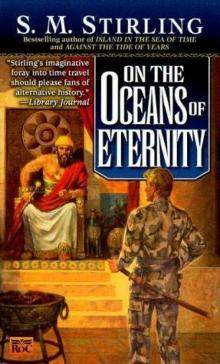 On the Oceans of Eternity
On the Oceans of Eternity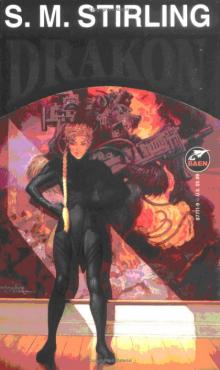 Drakon
Drakon Tales of Downfall and Rebirth
Tales of Downfall and Rebirth Rising Storm t2-2
Rising Storm t2-2 The Rose Sea
The Rose Sea Infiltrator t2-1
Infiltrator t2-1 Dies the Fire dtf-1
Dies the Fire dtf-1 Marching Through Georgia
Marching Through Georgia The Scourge of God c-2
The Scourge of God c-2 By Tooth and Claw
By Tooth and Claw The Sky People
The Sky People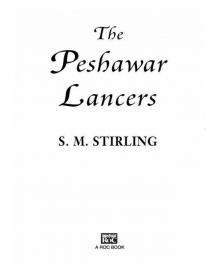 The Peshawar Lancers
The Peshawar Lancers Conqueror g-2
Conqueror g-2 Lord of Mountains: A Novel of the Change
Lord of Mountains: A Novel of the Change The Forge
The Forge Prince of Outcasts
Prince of Outcasts The Sword of the Lady c-3
The Sword of the Lady c-3 Sunrise Lands c-1
Sunrise Lands c-1 The Sword of the Lady
The Sword of the Lady The Golden Princess: A Novel of the Change (Change Series)
The Golden Princess: A Novel of the Change (Change Series) Emberverse 08: The Tears of the Sun
Emberverse 08: The Tears of the Sun The Sea Peoples
The Sea Peoples Island in the Sea of Time
Island in the Sea of Time The Desert and the Blade
The Desert and the Blade A Meeting At Corvallis
A Meeting At Corvallis Dies the Fire
Dies the Fire Shadows of Falling Night
Shadows of Falling Night Emberverse Short Stories
Emberverse Short Stories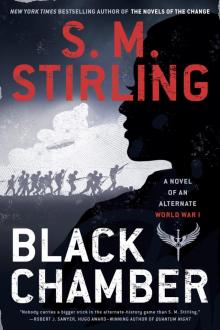 Black Chamber
Black Chamber The Future War t2-3
The Future War t2-3 Hope Renewed
Hope Renewed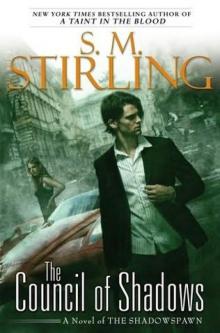 The Council of Shadows s-2
The Council of Shadows s-2 Sunrise Lands
Sunrise Lands Battlestations
Battlestations The Tears of the Sun
The Tears of the Sun Conquistador
Conquistador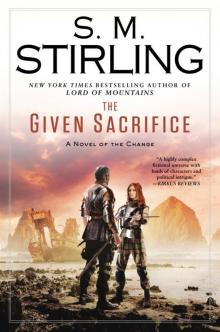 The Given Sacrifice c-7
The Given Sacrifice c-7 The Chosen
The Chosen Saber and Shadow
Saber and Shadow Ice, Iron and Gold
Ice, Iron and Gold The Sky-Blue Wolves
The Sky-Blue Wolves The Reformer g-4
The Reformer g-4 The Sword
The Sword A Taint in the Blood
A Taint in the Blood The Given Sacrifice
The Given Sacrifice The Council of Shadows
The Council of Shadows The High King of Montival: A Novel of the Change
The High King of Montival: A Novel of the Change The Anvil
The Anvil The Protector's War
The Protector's War